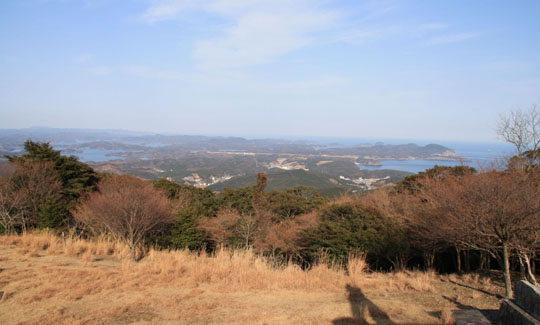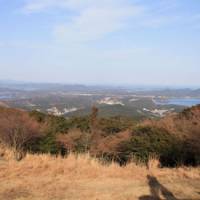There is a book in my library written by a Russian sailor named A. Novikoff Priboy who was captured by the Japanese during the Battle of Tsushima in 1905. His book was translated and published in English in 1933. It's a fine story, with vivid descriptions of the Russian squadron's epic journey from the Baltic to the Sea of Japan, of the great sea battle itself, and of his unexpected humane treatment by the Japanese after capture. It ends with Priboy's description of his last sighting of Tsushima from the ship repatriating him at the end of the war:
"On the summit of the island, which is but a mountain jutting out of the sea, is a peak cleft in twain, and known to mariners as 'the donkey's ears.' Henceforth this 'Peak of the Donkey's Ears' will remain an everlasting memorial over the tomb of the tsarist regime, dishonoured for all time, a regime of darkness and silence."
I spent a decade researching and writing naval novels set during the period of the Anglo-Japanese Alliance from 1902-23,* so I obviously knew of the disastrous defeat that the Japanese Combined Fleet under Admiral Heihachiro Togo dished out to the Russians on May 27-28, 1905, but very few modern Japanese seem to be aware of it. Recently, when I got a good view of the 519-meter cleft peak (named Shiratake in Japanese) that Priboy wrote about, my guides were surprised to hear me call it "the donkey's ears," referring to the historic naval battle and that long-gone Russian sailor.
I'd flown from Tokyo to Fukuoka the previous day, meeting up with my friend Reiko Amano, a well-known outdoor writer, before taking the short flight to Tsushima. Amano and I were met at the airport by officials from the local Foresters' Union and taken to a sushi shop, where a special treat awaited us courtesy of Isayoshi Hosoi, one of my former students from the nature conservation college I helped set up in 1994.
While at the college, Hosoi had joined a fishing vessel from Yakushima Island in Kagashima Prefecture as his fieldwork project. Then, after graduating — and marrying another graduate — he traveled all over Japan, seeking somewhere he could make his living as a fisherman. He ended up in Tsushima, where he has now been a professional fisherman for eight years and commands his own 15-meter boat with a 430-hp Yanmar diesel engine. Being an ardent conservationist, he chose single-line fishing rather than long-lining, drift netting or trawling, because this simple but highly skilled method cuts down on accidental catches.
The forestry folk were enormously impressed that a former student had delivered a 10-kg yellowtail (buri in Japanese) and a 4-kg sea bream (tai) he'd caught. The fish were served as sashimi, in a shabu-shabu hotpot, and as sushi. Fresh, delicious — and in huge quantities!
(The next day, Hosoi came to the symposium, bringing all his fishermen colleagues, and there delivered a short but brilliant speech from the floor about how poor forestry practices were seriously affecting fisheries due to erosion from the slopes being carried out to the bays and smothering marine growth. I was very proud of him!)
The symposium had been organized by Amano, together with the Foresters' Union and various town and Forestry Department officials. Key speakers were myself, Dr. Michiyuki Takeuchi from Kyoto University, Dr. Hisashi Kajiyama, who is now the senior adviser on forestry affairs to Deputy Prime Minister Naoto Kan, and Kiyochika Okahashi, president of Seiko Forestry Co. Ltd., based in Yoshino, Nara Prefecture.
Islanders were very surprised that the 900-capacity hall was actually packed with 935 people, and that for safety-law reasons about 200 others had to be turned away. That — and the fact that at least half those there were women, young and old — surely shows how much the islanders in general are concerned with the state and future of their forests.
The morning after I arrived, I was taken out by a professional guide, Toshiharu Nagato, a retired Forestry Agency official who was assigned to the island about 50 years ago, married a local lady, then returned to become a forest and nature guide after he retired from the government. With a young researcher involved in the study and conservation of the Tsushima wild cat acting as our driver, we went to see 100 hectares of original forest in the south of the island on the slopes of Tatera-yama, a 558.5-meter peak long considered holy, and which is the seat of the sun-worshiping Tendo religion.
In the forest I noted that pretty well all the big old trees were scarred by lightning strikes, whose obvious frequency must surely have made it a special and terrifying place to the island's early inhabitants. The forest was noted for huge sudajii (Castanopsis var. sieboldi; sweet-acorn tree), but many branches had fallen, and many old trees had been blown over in typhoons. The rudimentary paths were taped off in several places to discourage people from walking in danger zones. It seemed obvious to me that more time and money had been spent on the artificial park and center next door, the lawns of which had been widely dug up by wild boar foraging for worms or whatever else they could eat.
Interestingly, even though the Tsushima wild boar was supposedly wiped out in the Edo Period (1603-1867), in recent years they have made a dramatic comeback and now cause all kinds of damage. Did somebody clandestinely reintroduce them? If so, who and from where? Or were there a few surviving in the woods? The islanders I talked to all claimed they had only seen wild boar in recent years; they also pointed to rising numbers of indigenous deer and the island's plentiful martens and mice. There are no foxes, hares or raccoon dogs.
The island is very popular with birdwatchers, particularly for the spectacular migrations of hawks, harriers and eagles. It is also visited by the black-throated diver, otherwise known as the Arctic loon, a bird whose eerie, lilting, yodeling cry is symbolic of the wide, wild places of Canada and Alaska.
But back to the forests that had brought me here, and which cover about 90 percent of the island with a mixture of broad-leafed evergreens, conifers and deciduous trees. Ten percent of this forest belongs to the government, the rest being privately owned or run by cooperatives. In the olden days, the island was famous for big, high-quality cypress, though the best were cut down in the frenzied logging years of the 1950s, '60s and '70s.
On our way to see the ancient forest we had stopped at a vantage point, and I noted the hideous scars of bulldozed, zigzag tracks gouged out to access a mountainside for clear-cutting — an activity bound to trigger erosion whenever there are heavy rains. My guide shook his head and told me of how, in his day, they would have brought out the logs by overhead cables and slings, not with bulldozers and trucks. He said that whereas he could span a slope with 1,000 meters of cable, bringing the logs down to the valley, that technique is now lost and today's loggers can only use heavy equipment designed for construction.
Meanwhile, rice cultivation was brought to Tsushima from the mainland late in Jomon times around 300 B.C. The original crop was a red rice traditionally used for ceremonial purposes, although only one household now grows it — as a sacred crop for use in rituals.
However, another ancient food source, honey from native Japanese bees, is an important crop on Tsushima. At home in the Nagano Prefecture hills, we have our own bees, and we do our best to encourage wild Japanese bees (Apis cerana japonica) to use hives more convenient to get at than natural hollows in trees. We could do pretty well out of our honey if it were not for the competition from bears. There are no bears on Tsushima, though, and all the island's honey comes from native insects as there are no alien bees on the island. Due to its very high quality, this fetches four to five times the price of honey from European bees. I was surprised that the hives, often made of hollowed logs, are spaced quite closely. Certainly, if we spaced any two hives of Japanese bees that close here in Nagano, one or both would be abandoned as the residents flew off to found another colony. Unlike Japanese city folk, they don't seem to tolerate close neighbors — or maybe it's the absence of bears, and the stress they bring, that makes it easier for the Tsushima bees to get along with their neighbors.
Finally that day, considering my interest in naval history, my guides took me to see the Manzeki Channel, which provides a shortcut for ships moving to and from the deep and sheltered Aso Bay on the Korea Straits side of the island to the open waters of the Tsushima Straits. The channel was dug and blasted through a hill by the Imperial Navy between 1895 and 1904, and when first built it was 25 meters wide and 3 meters deep, though it was later widened and deepened as ships got bigger. Considering how close Korea and the Japanese mainland are to Tsushima, and if you reflect on the history of the Battle of Tsushima — as well as the Mongols' failed invasions in the 13th century and the 1950s Korean War — the island's strategic importance becomes abundantly clear.
Now, though, as you look down into the clear, fast-moving water, you see fish and coral and countless small oysters clinging to the rocks. It seems to be such a peaceful, special place despite all the strife that has surrounded it.
* Those novels, researched in Japan, Britain, Canada, Malta and Marseilles, France, were written in English and translated and published in Japanese by Bungei Shunju Publishing Co. To my deep chagrin, they have not been published in English.























With your current subscription plan you can comment on stories. However, before writing your first comment, please create a display name in the Profile section of your subscriber account page.